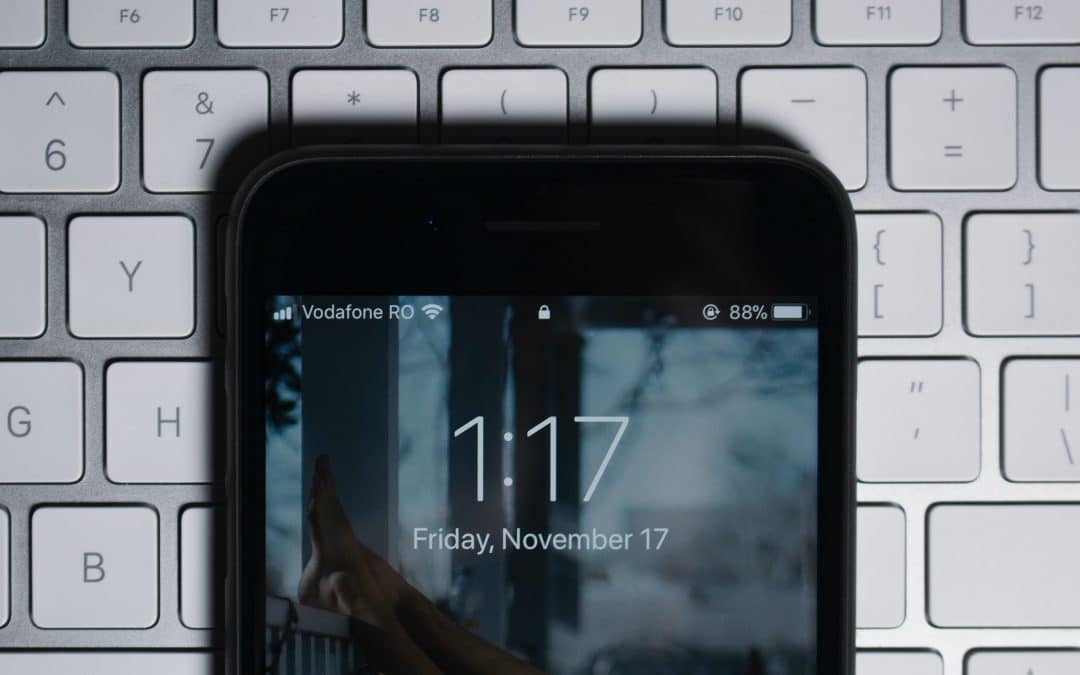John woke up like every other morning – 6:15 am, lying on his side, randomly outstretched arms. He left the orange bedding, raised the blinds, and yawned widely in the front of the day beginning. A messed-up room lit up.
It was time to get your act together and start working day. John wore his T-shirt and joggers, grabbed a coffee from a kitchen table, and went to the office. Then, he sat comfortably next to the computer screen; he turned on the computer and – put a small electronic device into his ear. Now, he was ready. Two minutes passed, and his brain tuned into the device, shifting into deep focus mode. One by one, John started to perform his daily tasks, sipping a coffee. Thanks to synchronizing his brain waves, the tiny electronic bug kept him perfectly focused on his work, so even his neighbor’s renovation didn’t interrupt him. Breakfast, lunch break, a short break to stretch, and after 8 hours, his high-performing working day finished. The laptop could be closed, and the tiny electronic bug could be removed from his ear until the next day. Unplugged.
Unfortunately, it’s just a fiction story, and we don’t have focus devices (yet!). We are just regular humans who get distracted at work. Every day, we have to fight obstacles and put great effort into concentrating at work.
We avoid noise, clutter, and disturbing people when developing a mindful workflow. But we tend to overlook one factor that significantly impacts our attention span – technology.
In this article, you will discover:
- How does technology affect our workflow?
- What is digital-mindful workflow?
- How to develop it on your own?
- Which apps can come in handy?
- How workflow, nature, and social support are linked together?

How does technology affect our workflow?
How does technology affect our workflow? There are many factors, ranging from our cognitive function, brain neuroscience, and mental health. Here you can find some discoveries from recent studies:
- Increased dopamine level. Smartphones overstimulate reward pathways in our brains. How does it happen? Every time we use smartphones, our brains release dopamine – the pleasure hormone. Dopamine is secreted while having sex, eating something tasty, and during successful social interactions, such as getting comments on pictures or messaging someone. So, when we use smartphones, our brains link them with social experiences and motivate us to use them more and more to get more and more delight. It raises our dopamine levels and makes us feel addicted to our digital devices.
- Diminished problem-solving abilities. According to research, checking mobile during work break affect problem-solving skills. Studies show that using cell phones doesn’t allow a brain to recharge, so participants who used them in between demanding cognitive tasks performed worse. But that’s not all – even the mere presence of smartphones on desks reduces our problem-solving abilities.
- The negative effect of task-switching. A wandering mind is powerful; when we don’t interrupt it, our brain falls into default mode, the state which allows us to look inward, think abstractly, and come up with innovative solutions. However, statistically, we check our phones 63 times a day, and every single time we disrupt the flow of our minds. It also has side effects – task switching raises our distraction and cortisol levels, making us more jittery at work.
It’s just the tip of the iceberg, but one thing is clear – even if we live in a technological environment, we work more effectively while being unplugged.

How to develop Digital-Mindful Workflow
A digital-mindful workflow is one in which you use digital devices consciously to reduce their harmful effects on your concentration. Thank God, it isn’t the Holy Grail – you don’t have to go on a dangerous journey to find it. It’s closer than you think, and achieving it is much easier than you could imagine. All you need to do is to learn how to be unplugged during working hours and how to rest afterward.
So – would you like to become resilient to digital devices? You are in the right time and place. Today, I’m sharing ten steps to developing a workflow that will be mindful, effective, and free of digital distractions.
1. Identify Problems
There are some general rules about planning your work routine to make it efficient and peaceful. However, even though we are similar as people and certain tendencies apply to the general population, each of us is different, and we all face our own challenges. Thus, the first step to change is to identify your specific concerns. When it comes to digital habits, digital tools surprisingly can help. Some apps track your time using your digital devices and various apps. This solution allows you to study your tech patterns and figure out how much time you spend on your phone unconsciously. You may be surprised at how much time you spend on certain apps!
The list of useful mobile apps:
The list of useful desktop apps:
2. Schedule Your Digital Time
When we try to limit something, we usually use two strategies – scheduling a time when we avoid it or when we can afford that “forbidden” activity. A good example is dieting: some people prefer to set a ban on eating after 6 pm, and others opt for doing a cheat day every Saturday. The same can be applied to getting unplugged. In my experience, scheduling a specific time to use my smartphone seems more pleasant than planning hours when I can’t do it. It changes my perspective because instead of restricting myself constantly, I tend to look forward to the time when I can allow myself that luxury. So, my suggestion is to schedule using smartphones – or particular activities, like browsing Reddit or Pinterest for a specific time a day. Not only will this allow you to control the time you spend on it, but you will feel it as an enjoyable reward.
3. Create Healthy Habits
In the words of Jim Rohn – Motivation is what gets you started. Habit is what keeps you going. I suppose that you are motivated because you’re reading this article. It’s an excellent start! So now it’s time to continue – let’s create long-lasting habits.
Here are some examples of practices that can help you to maintain a digital-mindful workflow:
- Don’t check news and social media platforms right before your working time. The web is an ocean of information, and you can’t control what you will see there. If you get interrupted by annoying messages or depressing news, your mind won’t be able to focus on your work.
- Go to the toilet alone. Yes, nearly 80% of men and 69% of women admit to using their phones on the toilet. No judgment here; I’m just saying it’s an unnecessary job distractor!
- Ask yourself “why?” every time you unlock your smartphone to learn to use it only on purpose.
4. Hide Distractors
How do you think – would you feel tempted to use a smartphone if you won’t get it in your sight? Experiment and try to remove all digital tools you do not use at work from your workspaces – such as smartphones and tablets. Spoiler alert – it works! Simply looking at digital devices turn the mind into games to play, news to read, and people to message. But you don’t see them; your mind focuses on work rather than entertainment.
5. Use Website & App Blockers
Not all of us can hide our digital devices – some professions require using smartphones and laptops for everyday work. But what if I say you can hide just a part of your smartphone – such as a particular app? Yes, unique blocking apps block access to specific websites or mobile apps you want to avoid during working hours. In other words, this solution doesn’t leave you a choice – it closes all non-work-related websites, so you have to return to work.
The list of useful web apps:
The list of useful smartphone apps:
6. Try Productivity Techniques
Have you heard about the Rule of Three, the Two-minute or Pomodoro technique? The last is my favorite one. Pomodoro is a productivity technique that claims we are most productive while working for 25 minutes intertwined with 5 minutes of break. It’s verified by experts and by the experience of many people (including me). However, the effectiveness of this strategy depends on the type of duties. I feel it works better for repetitive tasks than creative work. Anyway, I recommend trying it on your own and exploring other strategies. Perhaps it will inspire your process.
- The online Pomodoro timer: https://pomodorokitty.com/
7 Redesign Your Office Space
Our workplace dramatically impacts our mood, concentration, and, in turn, our performance. According to the Global Impact of Biophilic Design in the Workplace study, well-being in offices with natural features is 15% higher. Let’s start with minor changes, such as placing a flower on your desk. Ideally, your windows overlook the park, garden, or a city square, and you can look out there during breaks.
8. Go Outdoor
I mentioned it before, but I’m never tired of repeating – nature is the best remedy for technology fatigue. Technology allows us to experience the whole world, but at the same time, it narrows the world as an entire to small electronic devices. In nature, it’s quite the opposite. You can enjoy only a tiny part of the world at once, but you can experience it with all your senses, and it surrounds you. Thus, nature provides all stimuli you can’t get while using tech. Going outdoor at your leisure allows you to rejuvenate and return to work with a fresh mind. Another benefit of leaving your phone at home is avoiding the temptation to work during your downtime, which almost seven out of ten employees admit to doing.

9. Give a Chance to Analog Alternatives
The best about tech devices is they integrate many functions into one. Using your smartphone, you can navigate by maps, learn a language by apps and snap photos! But you don’t have to use all those smartphones’ functionalities just because they are accessible. Indeed, one of the solutions to limit tech usage is using analog alternatives. During your working day, you can use the regular alarms clock, paper notebook, and mp3 instead of your mobile phone. Just give a chance to old-school options.
10. Get Social Support
I feel that behind every life change I made were the people who supported it. Whether it was a Master’s thesis, moving to another country, or starting a new hobby, encouragement from friends and family gave me the confidence to tackle these challenges. It taught me to share whenever I plan to make a significant change with my loved ones, even if it’s “just” a workflow. So I suggest you do the same – share your upcoming changes with your friends! Tell them what caused your decision, what may be your difficulties, and how you want to achieve it. Their support will be invaluable on hard days when you might want to quit.
Final thoughts
And now it’s time for the final question: after reading this article, do you still wish you had the focusing device from the opening story? Or does it turn out that we don’t need it at all because we have all the skills within us?
Fingers crossed for your workflow-development journey! Feel free to share with me your thoughts and stories at k.zajac@photoaid.com.

